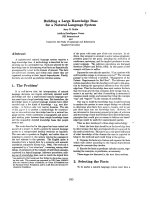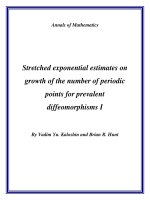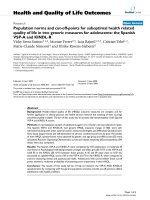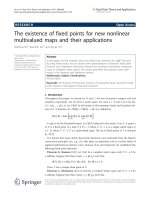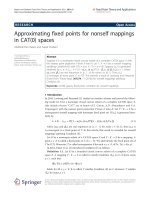Modeling filtered building effluent stack sampling points for qualification criteria
Bạn đang xem bản rút gọn của tài liệu. Xem và tải ngay bản đầy đủ của tài liệu tại đây (1.55 MB, 7 trang )
Progress in Nuclear Energy 124 (2020) 103338
Contents lists available at ScienceDirect
Progress in Nuclear Energy
journal homepage: />
Modeling filtered building effluent stack sampling points for
qualification criteria
J. Matthew Barnett *, Xiao-Ying Yu , Sarah R. Suffield , Kurtis P. Recknagle
Pacific Northwest National Laboratory, P.O. Box 999, Richland, WA, USA
A R T I C L E I N F O
A B S T R A C T
Keywords:
CFD
Standards
Modeling
Radioactive air
Proposed construction of or changes to a radiological effluent stack must meet the mixing criteria at the sampled
stack location required by the standards ANSI/HPS N13.1–2011 and ISO 2889. For more than a decade, threedimensional computational fluid dynamics (CFD) models of such stacks have been used to assist in characterizing
the sample location suitability. When inadequate mixing in the stack at the sampling location has been identified,
additional modeling was used. Testing results have confirmed the CFD model predictions with similar values in
both scale model and full-scale stack tests. Simulations of a stack scheduled for modifications can evaluate
mixing at the limits of operation, recommend modifications, and indicate if the retrofitted stack passes criteria
for baseline operating conditions. This work demonstrates CFD modeling is an effective design tool and should be
considered to facilitate qualification of a stack sampling location to meet standards.
1. Introduction
The U.S. Department of Energy has a number of research and
development facilities throughout the United States, one of which is
Pacific Northwest National Laboratory (PNNL) located in southeastern
Washington State. For buildings with radiological capabilities, the air
discharged from the exhaust stack system may be monitored for radio
nuclides. Furthermore, the air monitoring systems must comply with
applicable federal regulations, which require a sampling probe in the
exhaust stream, aligned with the duct axis, to conform to the criteria of
the ANSI/HPS N13.1–2011 (Health Physics Society HPS, 2011) stan
dard. This standard requires that the sampling location be well-mixed
and stipulates specific requirements for cyclonic flow, velocity, and
gas and aerosol concentration uniformity to verify the extent of mixing.
In qualification testing, quantities are measured manually along hori
zontal and vertical traverses at predetermined distances established by
the standard. Uniformity is determined by the coefficient of variance
(COV), which is defined as the standard deviation divided by the mean,
expressed as a percent. The criteria require the maximum average
cyclonic flow angle be � 20� , COV for the flow velocity uniformity be �
20%, COV for the gas concentration uniformity be � 20% and at no
point in the sampling plane does the gas concentration vary from the
mean by > 30%, and COV for the particle tracer concentration unifor
mity be � 20%. ISO 2889 (International Standards Organization (ISO),
2010) is the international version of ANSI/HPS N13.1.
Testing must be performed on all new and retrofitted stacks to
demonstrate system compliance. Testing options are provided in the
ANSI/HPS N13.1–2011 standard. One of three approaches may be
taken: 1) perform a full test series on the actual exhaust system, 2)
perform the full test series on a scale model of the exhaust system, fol
lowed by a partial test of the actual exhaust system to verify the scale
model results, or 3) adopt results from previously performed full test
series for a system with a similar configuration, followed by a partial test
of the actual exhaust system to verify the applicability of the previous
test results. Options 1 and 2 can be very expensive, and the viability of
Option 3 depends upon the available data. If stack compliance testing
reveals the need for stack alterations to comply with the standard,
additional costs are incurred for retrofitting and retesting. Properly
implemented, CFD modeling is much less expensive than the physical
testing to evaluate the system performance. When exercising any of the
three options, modeling can and has been employed to preview and
evaluate stack mixing performance to inform stack design and testing
decisions.
Various CFD application to radioactive air emissions has been
considered over the past one to two decades. In particular, Tang and Guo
(2011) reported on aerosol transport and deposition, while Vijayar
aghavan (2006) simulated turbulent mixing in tubing, which was
compared to experimental results for velocity and tracer gas
* Corresponding author.
E-mail address: (J.M. Barnett).
/>Received 3 June 2019; Received in revised form 2 March 2020; Accepted 20 March 2020
Available online 8 April 2020
0149-1970/© 2020 Elsevier Ltd. This is an open access article under the CC BY license ( />
J.M. Barnett et al.
Progress in Nuclear Energy 124 (2020) 103338
Fig. 1. Stack model of the preliminary (four-fan) system showing (a) the layout with the sampling point (location) and fan exit plane feature locations, and (b)
computational mesh at the inlet (fan exit plane) which is similar throughout the model domain.
concentrations. Additional CFD works have considered air mixing and
particle transport on both scale models as well as for a modified stack
(Ballinger et al., 2014; Recknagle et al., 2009; and Barnett et al., 2016).
Other applications of CFD modeling have been applied to nuclear
reactor accident events to assess fission product deposition in pipes
(Dwivedi et al., 2019), and to the volume of fluid method to simulate the
gas entrainments process and capture the dynamic liquid-gas interface
at a propagating slug front (Hua et al., 2015) which tangentially support
this approach of establishing a well-mixed sample location in stacks or
ducts of nuclear facilities.
This work is significant because it supports expanding the physical
testing requirements to allow CFD modeling as an option in the stan
dards. In particular, the more expensive physical scale-model tests or
full-scale testing can be supplemented by the use of CFD modeling prior
to construction. In such cases, the CFD modeled results of the exhaust
system are followed by a partial physical test of the actual exhaust
system to confirm the well-mixed sample location requirements are met.
plane of each fan duct. An example of such a stack system model domain
is shown in Fig. 1a, and a partial view of the computational mesh in
Fig. 1b. The models are meshed with sufficient refinement to enable
resolution of the turbulent flow field and provide accurate calculations
of the particle tracks throughout the system.
A grid sensitivity (mesh independence) study was conducted to
ensure sufficient representation of the model by changing the mesh until
the simulation results did not significantly vary (i.e., converge) with
further mesh refinement. The CFD convergence associated with mesh
independence satisfied the conditions of the residual root-mean-square
(RMS) error values reduced to an acceptable value, the monitored
point(s) of interest reached a steady solution, and low domain imbal
ances (e.g., less than 1%). To achieve grid-independence, the resulting
typical computational mesh for a nuclear facility stack system with
sufficient refinement contains approximately a million or more
elements.
When physical tests are conducted, the stack sampling methodology
assumes isothermal conditions exist within the stack. Accordingly, this
assumption is adopted in the CFD modeling methodology. Simulations
of the isothermal flow solve the Navier-Stokes conservation of mass and
momentum equations, which for steady flow are expressed in Eqs. (1)
and (2):
2. Modeling methodology
The methodology used for the CFD modeling presented here includes
defining the system with geometric detail, physics models, and bound
ary conditions suitable to represent the flow and mixing that occurs
within the actual stack system and distributions of gas and particle
tracers throughout the system, and particularly at the sampling point.
Other CFD work has considered air mixing and particle transport at a
smaller scale. In particular, Tang and Guo (2011) reported on aerosol
transport and deposition, while Vijayaraghavan (2006) simulated tur
bulent mixing in tubing, which was compared to experimental results for
velocity and tracer gas concentrations.
To successfully predict the distributions of the tracer gas (e.g.,
nitrous oxide [N2O]) and particulates (e.g., oil droplets) requires accu
rate modeling of the air flow (carrier phase) and transport of the tracers
(dispersed phases). The geometry of the typical filtered building exhaust
system is complex and three-dimensional (3-D). As such, a boundaryfitted, 3-D flow solution is also required. The commercially available,
CFD general-purpose flow simulation codes, STAR-CD (2001), and more
recently, STAR-CCMỵ (2017), were used for system simulations. These
codes contain widely tested flow, turbulence, multiphase and
multi-physics models, and meshing capabilities for creating highly
resolved 3-D computational domains from computer-aided design (CAD)
geometry models.
The CFD models consider the geometric detail of the stacks from just
downstream of the inlet fans and dampers to the stack exit. While the
fans are not included in the model domain, turbulence generated up
stream in the ductwork and through the fans is accounted for at the exit
∂ À �
ρuj ¼ 0
∂xj
(1)
�
∂ À
∂p
ρuj ui À τij ¼ À
∂xi
∂xj
(2)
where the ui are the absolute fluid velocity components in coordinate
directions xi (i ¼ 1, 2, 3) while the j subscript, when present with i, in
dicates coordinate directions other than i; ρ is the density, p is the
pressure, and τij is the fluid stress tensor, which for turbulent flow is
represented by Eq. (3):
τij ¼ 2μσij À
2 ∂uk
μ δij À ρu’i u’j
3 ∂xk
(3)
Here μ is the dynamic viscosity, σij is the rate of strain tensor, δij is the
Kronecker delta, uiʹ and ujʹ are fluctuations about the average velocity,
and the overbar indicates the averaging of the fluctuations. The rightmost term in Eq. (3) represents the additional Reynolds stresses due to
turbulent motion. These are linked to the mean velocity via the turbu
lence model being used. In the simulations for this work, turbulence is
handled with a realizable k-ε model. This k-ε model is a widely tested
and validated two-equation closure model for the Reynolds-averaged
Navier-Stokes (“RANS”) equations and has been shown to be suitable
for this class of duct flow simulation (Recknagle et al., 2009; Jensen,
2
J.M. Barnett et al.
Progress in Nuclear Energy 124 (2020) 103338
of velocity, gas, and aerosol tracers with ANSI/HPS N13.1–1999 criteria
(Health Physics Society HPS, 2011). The scale-model test results and the
full-scale CFD model results would then be applied to evaluate the
sampling location on the full-scale stack. In benchmarking against the
scale-model results, the 3-D CFD modeling results closely matched most
uniformity criteria and conservatively predicted uniformity of gas and
particle tracers. In simulations of the full-scale stack, the CFD model
showed the full stack length was needed for sufficient mixing and thus
advised against moving the sampling location to a more advantageous
site (Recknagle et al., 2009; Barnett et al., 2013). More details on this
earliest modeling work, and the application to an extended set of flow
conditions, is available elsewhere (Ballinger et al., 2011).
In 2012–2013, an existing PNNL building exhaust stack was to be
modified to expand the ventilation capacity. The modifications would
upgrade the two-fan (as-built) system to a three-fan system to meet
additional capacity requirements. The mixing performance was first
evaluated with CFD (Recknagle et al., 2013). Initial modeling of the
as-built system showed good agreement with onsite testing of flow angle
and velocity uniformity as shown in Table 1; however, this onsite testing
to evaluate the as-built stack did not include tracer gas and particle
distribution testing because the as-built stack qualification relied upon
previous testing of a similar stack (Glissmeyer and Droppo, 2007) for the
tracer mixing qualification, as is permissible in the ANSI/HPS N13.1
standard. While simulation results of the three-fan system showed
acceptable flow angle and velocity uniformity, the gas and particle
tracer COVs were unacceptably high. When two or three fans were
operated, tracers in the flow showed the streams from each fan were
slow to mix; a finding consistent with the previous testing. The instal
lation of an air blender was proposed to correct the poor mixing indi
cated by the modeling and was added to the CFD model downstream of
the last fan. With the air blender included, the model predicted the stack
would pass all mixing criteria of the standard. Results of the three-fan
system model are summarized in Table 2, columns 2 and 3, and show
the striking improvement made by the air blender (Recknagle et al.,
2013; Yu et al., 2013). The blind predictions were later confirmed by
testing of the completed stack (Yu et al., 2013, 2014) (Table 2, column
4), fulfilling the standard requirements. In this work, the CFD modeling
indicated the need for the air blender. Modeling with the air blender
matched the later testing results to within 5 COV%, a requirement for
use of surrogate stack testing data.
Table 1
Comparison of CFD validation model and original configuration test result
ranges (Recknagle et al., 2013).
Criteria evaluated
CFD validation
model, Two-fan
design
Original two-fan
full scale test,
As built
ANSI/HPS
N13.1criteria
Velocity
Uniformity
COV (%)
Cyclonic Flow
Angle (� )
3.6–7.0
2.4–4.3
�20
5.2–6.4
3.3–11.0
�20
2007).
For the tracer gas, a model is used in which species k of a gas mixture,
with local mass fraction Yk is governed by a species conservation
equation as in Eq. (4):
uj Yk ỵ Fk;j ẳ Sk
xj
(4)
where Fk,j is the gas diffusional flux component and Sk is the gas species
source term, which is non-zero at the injection location.
A Lagrangian multiphase model that considers the interactions of
mass, momentum, and energy between the continuum and dispersed
phase is used for the tracer droplet/particle transport. For the stack
modeling work, droplet concentrations are small, thus we only consider
momentum transfer from the air to droplets. In the model, the mo
mentum equation for a droplet, given by Newtons second law, is shown
in Eq. (5):
md
dud
ẳ Fdr ỵ Fp ỵ Fb
dt
(5)
where md and ud are the mass and velocity of the dispersed droplet
phase, Fdr is the drag force, Fp the pressure force, and Fb is the body force
including effect of the gravity and angular velocity vectors. Surface
vapor pressure and mass transfer between phases are not considered
here. Because the problem is considered isothermal and is also assumed
to not involve electrically charged flow, thermophoresis and electro
static effects are not included. Also, because of the low droplet con
centration, separation and coalescence are neglected as well.
Mass inflow boundaries are established at the duct inlets with tur
bulence intensity and length scale settings to account for upstream
turbulence including the fans. A pressure boundary with 1.0 atm abso
lute pressure is used at the stack exit. Duct walls are modeled as smooth
surfaces with zero slip flow boundary conditions. The particle boundary
condition at the walls is established such that droplets with trajectories
that impact the duct walls will remain on the surface.
2.2. Present stack modeling
In 2017–2018, another PNNL building filtered exhaust stack was
identified for modification to expand the ventilation capacity. In this
case, the modifications would upgrade an existing three-fan (as-built)
system to a four-fan system to meet capacity requirements. As with the
previous case, tracer distributions may be adapted from previous testing
of a similar system, a practice used for the existing original as-built
system (Glissmeyer and Flaherty, 2010). Although previous CFD simu
lations provided good results, additional validation of the modeling
methodology was desired to increase confidence that CFD would pro
vide good predictions for the four-fan system. To do so, we benchmarked
the model results against previous testing data used to qualify the
as-built system. In the previous tests, the full suite of mixing requirement
2.1. Stack modeling history
PNNL has recommended and has been using CFD to model radio
logical effluent stacks since the early 2000s (Ballinger et al., 2004, 2014;
Barnett et al., 2013).
Initially, the commercial CFD code STAR-CD was used to compare
the results of physical scale-model tests for cyclonic flow, and uniformity
Table 2
Three-fan design results of CFD original modeling, CFD modeling with an air blender, and full-scale stack testing (Barnett et al., 2016).
Criteria Evaluated
CFD Modeling:
Original
CFD Modeling: with
Air Blender
Full-Scale Testing
with Air Blender
ANSI/HPS N13.1
Acceptance Criteria
Maximum Difference Between Model
and Test with Air Blender
Velocity Uniformity COV (%)
Cyclonic Flow Angle (� )
Gas Tracer Uniformity COV (%)
Gas Tracer Maximum Deviation from
the Mean (% of mean)
Particle Tracer Uniformity COV (%)
4.7–6.3
5.8–7.5
4.1–29.0
6.5–54.0
2.2
0.3
1.7
3.0
1.9–2.9
1.4–4.0
0.5–2.8
6.7
�20
�20
�20
�30
0.7
3.7
1.2
3.7
36–58
11.6
6.5–9.9
�20
5.1
3
J.M. Barnett et al.
Progress in Nuclear Energy 124 (2020) 103338
(Fig. 2). When expansion and contraction sections are added to
accommodate the diameter difference, the flow tends to concentrate in
the central portion of the air blender, the counter-rotating flow is not
present, and the pressure drop is large. CFD models of straight ducts with
various lengths of expansion and contraction sections were created and
used to design a duct section to incorporate the oversized air blender. A
series of test cases revealed that long, low-angle expansion and
contraction sections and short straight sections adjacent to the blender
provided the needed counter-rotating flow through the blender and
mixing of tracer gas and particles, with a pressure drop of only 0.71-cm
(0.28-in.) water column. The modified duct incorporating the expan
sion, air blender, and contraction was incorporated into the four-fan
stack design geometry (see Fig. 3).
Prior to simulating the full array of expected flow scenarios, a test
simulation of the modified four-fan design with four fans operating at
9.4 m3 sÀ 1 (20 kcfm) each for a total exhaust rate of 37.8 m3 sÀ 1 (80
kcfm) was performed to check the effectiveness of the system mixing
performance and sampling location. Fig. 4 shows the mid-duct velocity
magnitude profile in the plan view, and the velocity distribution at the
sampling location traverse (cell values are interpolated to provide
smooth contours). The red dots represent the horizontal and vertical
sample point locations for this stack. Flows from each fan entering the
main duct at an angle creates a swirling flow that remains along the
duct, including the expansion section. Flow through the air blender es
tablishes a counter-rotating flow. Once through the contraction section,
most mixing is complete and the flow travels towards the sampled sec
tion with reduced swirl. For this test case, the maximum flow angle, at
the sample location, is 6.8� , and the COV of velocity uniformity is 2.1%.
Table 3
Benchmark comparison of CFD model and testing data (Glissmeyer and Droppo,
2007).
Criteria
Evaluated
Physical
Test
Results
CFD
Model
Results
ANSI/HPS
N13.1
Acceptance
Criteria
Difference
Between Test
Results and
Model
Velocity
Uniformity
COV (%)
Cyclonic Flow
Angle (� )
Gas Tracer
Uniformity
COV (%)
Particle Tracer
Uniformity
COV (%)
5.5
4.6
�20
0.9
4.2–4.6
3.3
�20
1.3
10.5
11.0
�20
0.5
17.6
19.5
�20
1.9
data was collected (i.e., flow angle, velocity, and gas and particle tracer
uniformity) (Glissmeyer and Droppo, 2007). A boundary-fitted CFD
model of the tested stack was constructed and inputs were set to match
flow conditions of potentially comparable test cases, particularly those
performed without dampers installed. The benchmarking results sum
marized in Table 3 show that the modeling results agree well with the
mixing requirement testing data, thus providing confidence and vali
dation of the modeling methodology.
All potential operating scenarios of the four-fan system must be
checked with CFD simulations to ensure ANSI/HPS N13.1–2011 stan
dard criteria are met under all operational conditions. These operating
scenarios include flows involving any number of the four fans and flow
rates in the range of 7.8–47.2 m3 sÀ 1 (16.5–100 kcfm) in the 157.5-cm
(62-in.) duct. For standard operations, any combination of three fans
operate with one held in reserve. Simulations of the preliminary four-fan
system, as pictured in Fig. 1, were performed. A total of 10 cases
(including one-, three-, and four-fan operations) encompassing the full
range of flow rates were run; four failed to meet the acceptance criteria
for the gas tracer uniformity, and seven failed to meet the acceptance
criteria for the particle uniformity. None of the two-fan cases were
simulated because of the challenges met by the other cases. The cases
that were run are summarized in Table 4.
Because of tracer mixing challenges seen with the preliminary fourfan model, and the subsequent uncertainty that the stack would meet the
standard criteria, a stationary air blender was considered for inclusion in
the stack system. Fig. 2 shows a typical stationary air blender.
Preferably, addition of an air blender would not increase the system
pressure drop relative to the initial four-fan design by more than 0.64cm (0.25-in.) of water column for a flow rate of 35.4 m3 sÀ 1 (75
kcfm). An air blender of the same diameter as the main duct would
create too large a pressure drop unless the blade angles are substantially
decreased. Unfortunately, the decreased blade angle would not provide
sufficient mixing to enable the system to meet the standard criteria. An
oversized air blender and stack section of larger diameter than the main
duct was subsequently used to maintain a low system pressure drop and
provide sufficient mixing.
When installed in the main duct, the configured air blender has a
well-established counter-rotating flow through the central and annular
portions of the device, which provides the needed energetic mixing
Fig. 2. Typical static air blender with turning vanes in the central section, and
opposite direction vanes in the annular section.
Table 4
Summary of CFD model simulations of the preliminary four-fan system and cases that pass or fail the ANSI/HPS N13.1 acceptance criteria.
Number of Operating
Fans
Flow (m3 sÀ
[kcfm])
1
3
4
4
7.8 [16.5]
33.0 [70]
37.8 [80]
47.2 [100]
1
Flow Angle (� )
Velocity COV (%)
Gas Tracer COV (%)
Particle Tracer COV
(%)
ANSI/HPS N13.1 Criteria, Pass/
Fail
6.3
3.2–3.8
2.9
3.0
6.9
2.4–6.7
4.6
4.2
2.24
6.3–38.6
5.9–31.3
2.24
60.7
13.2–30.1
24.8–55.7
60.7
0/1
3/1
0/4
0/1
4
J.M. Barnett et al.
Progress in Nuclear Energy 124 (2020) 103338
Fig. 3. The modified four-fan stack system with static air blender. The distance from the last fan to the sampling point is 24.3 m (79.6 ft), and the distance from the
sampling point (location) to the next transition is 3.5 m (11.6 ft).
Fig. 4. Velocity contours through the modified duct centerline with 4 fans operating at 37.8 m3 sÀ
traverse location.
1
(80 kcfm). Shown in: (a) plan view, and (b) at the sampled
Table 5
Summary of CFD model simulations of the modified four-fan system with stationary air blender installed and cases that pass or fail the ANSI/HPS N13.1 acceptance
criteria.
Fans Operating
Flow (m3 sÀ
1
2
3
4
4
7.8 [16.5]
15.6 [33]
33.0 [70]
37.8 [80]
47.2 [100]
1
[kcfm])
Flow Angle (� )
Velocity COV (%)
Gas Tracer COV (%)
Particle Tracer COV (%)
ANSI/HPS N13.1 Criteria (Pass/Fail)
0.8–6.6
0.8–2.6
1.8–5.3
6.8
6.9
1.9–4.1
1.6–2.5
1.58–1.62
2.1
2.0
0.1–0.47
0.3–1.9
1.2–3.5
0.9–3.2
0.9–3.0
15.9–19.0
11.4–19.7
13.8–19.4
16.2–18.9
15.6–19.8
4/0
4/0
4/0
4/0
4/0
5
J.M. Barnett et al.
Progress in Nuclear Energy 124 (2020) 103338
Fig. 5. Mass fraction of N2O tracer gas injected mid-duct at Fan A, with 4 fans operating at 37.8 m3 sÀ
traverse location.
1
Fig. 6. Particle concentrations for tracers injected mid-duct at Fan A, with 4 fans operating at 37.8 m3 sÀ
traverse location.
6
(80 kcfm). Shown in: (a) plan view, and (b) at the sampled
1
(80 kcfm). Shown in: (a) plan view, and (b) at the sampled
J.M. Barnett et al.
Progress in Nuclear Energy 124 (2020) 103338
Table 5 indicates other model data for this and other scenarios.
Similar effects due to four-fan flow patterns in the duct and blender
for gas and particle tracer distributions are shown in Figs. 5 and 6,
respectively. Environmentally friendly N2O tracer gas (Yu et al., 2018)
was injected near Fan A. Fig. 5 shows the mid-duct N2O mass fraction in
the plan view and at the sampled section. The effect of mixing is most
evident downstream of the air blender. The gas tracer COV for this case
is 2.23%. Ten-micron aerodynamic diameter tracer particles also were
released near Fan A. Particle (parcel) tracks from the Lagrangian solu
tion are shown in Fig. 6. The tracks are displayed by parcel number to
(provide color which helps distinguish and visualize the varying paths.
Tracks are shown in plan view and at the sampling location. The latter
shows a good distribution across the sampled traverse. The COV for this
particle distribution is 16.2%. This simulation illustrates how uniform
the particle distribution must be to result in particle COV �20%.
It is necessary to check that all flow conditions will meet the criteria
set forth in the ANSI/HPS N13.1–2011 standard. While the original
compliant three-fan system was designed for normal operations in the
range of 23–26 m3 sÀ 1, the modified four-fan system with a stationary
air blender is expected to operate in the range of 33–36 m3 sÀ 1 and
continue to be well-mixed at the sampling location. Thus, the full array
of standard flow condition cases were modeled using the modified fourfan system with an air blender. The results of these runs are summarized
in Table 5, which shows that the modeling results predict that flow angle
(1� to 7� ), velocity COV (2%–4%), gas tracer COV (0%–4%), and particle
tracer COV (11%–20%) meet criteria established by the ANSI/HPS
N13.1–2011 standard when the air blender is installed using the CFDdesigned duct section.
Laboratory, which is operated for the U.S. Department of Energy by
Battelle under Contract DE-AC05-76RL01830.
Appendix A. Supplementary data
Supplementary data to this article can be found online at https://doi.
org/10.1016/j.pnucene.2020.103338.
References
Ballinger, M.Y., Recknagle, K.P., Barnett, J.M., 2014. Comparison of a computational
fluid dynamics model with exhaust flow data from a scale model stack. In: Barnett, J.
M., V�
azquez, G.A., Bates, C.J., Anderson, S.V. (Eds.), 2003 Annual NESHAP Meeting
on Radioactive Air. PNNL-SA-101801. Pacific Northwest National Laboratory,
Richland, WA.
Ballinger, M.Y., Barnett, J.M., Glissmeyer, J.A., Edwards, D.L., 2004. Evaluation of
sampling locations for two radionuclide air-sampling systems based on the
requirements of ANSI/HPS N13.1-1999. Health Phys. 86 (4), 406–415.
Ballinger, M.Y., Glissmeyer, J.A., Barnett, J.M., Recknagle, K.P., Yokuda, S.T., 2011.
Sampling Point Compliance Tests for 325 Building at Set-Back Flow Conditions.
PNNL-20397. Pacific Northwest National Laboratory, Richland, WA.
Barnett, J.M., Ballinger, M.Y., Recknagle, K.P., Yokuda, S.T., 2013. Computational
modeling of a stack sampling location for radioactive air emissions. PNNL-SA-46511.
In: Barnett, J.M., Vazquez, G.A., Bates, C.J. (Eds.), 2005 Annual NESHAP Meeting on
Radioactive Air. Pacific Northwest National Laboratory, Richland, WA.
Barnett, J.M., Yu, X.-Y., Recknagle, K.P., Glissmeyer, J.A., 2016. Modeling and
qualification of a modified emission unit for radioactive air emissions stack modeling
compliance. Health Phys. 111 (5), 432–441. />HP.0000000000000557.
Dwivedi, A.K., Khan, A., Tripathi, S.N., Joshi, M., Mishra, G., Nath, D., Tiwari, N.,
Sapra, B.K., 2019. Aerosol depositional characteristics in piping assembly under
varying flow conditions. Prog. Nucl. Energy 116, 148–157.
Glissmeyer, J.A., Droppo, J.G., 2007. Assessment of the HV-C2 Stack Sampling Probe
Location. PNNL-16611. Pacific Northwest National Laboratory, Richland, WA.
Glissmeyer, J.A., Flaherty, J.E., 2010. Assessment of the 3420 Building Filtered Exhaust
Stack Sampling Probe Location. PNNL-19563. Pacific Northwest National
Laboratory, Richland, WA.
Health Physics Society (HPS), 2011. Sampling and Monitoring Releases of Airborne
Radioactive Substances from the Stacks and Ducts of Nuclear Facilities. ANSI/HPS
N13.1-2011, McLean, VA (ANSI/HPS N13.1–2011 is a reissue of ANSI/HPS
N13.1–1999 and is essentially unchanged).
Hua, J., Nordbø, J., Foss, M., 2015. CFD modelling of gas entrainment at a propagating
slug front. In: Olsen, J.E., Johansen, S.T. (Eds.), Progress in Applied CFD. SINTEF
Academic Press, Oslo, Norway.
International Standards Organization (ISO), 2010. Sampling Airborne Radioactive
Materials from the Stacks and Ducts of Nuclear Facilities. ISO 2889, Geneva,
Switzerland.
Jensen, B.B.B., 2007. Numerical study of influence of inlet turbulence parameters on
turbulence intensity in the flow domain: incompressible flow in pipe system.
Proceedings of the Institute of Mechanical Engineers Part E. J Process Mech Eng 221,
177–186, 2007.
Recknagle, K.P., Yokuda, S.T., Ballinger, M.Y., Barnett, J.M., 2009. Scaled tests and
modeling of effluent stack sampling location mixing. Health Phys. 96 (2), 164–174.
Recknagle, K.P., Suffield, S.R., Barnett, J.M., 2013. Modeling the Air Flow in the 3410
Building Filtered Exhaust Stack. PNNL-22185. Pacific Northwest National
Laboratory, Richland, WA.
STAR-CD, 2001. Version 3.15, Methodology Volume, â. Computational Dynamics Ltd.
STAR-CCMỵ, 2017. Version 12.06, User Guide, Siemens PLM Software Simcenter, ©.
Siemens Product Lifecycle Management Software Inc.
Tang, Y., Guo, B., 2011. Computational fluid dynamics simulation of aerosol transport
and deposition. Front. Environ. Sci. Eng. China 5 (3), 362–377. />10.1007/s11783-011-0365-8.
Vijayaraghavan, V.K., 2006. Numerical Modeling of Species Transport in Turbulent Flow
and Experimental Study on Aerosol Sampling. Dissertation. Texas A&M University,
College Station, TX.
Yu, X.-Y., Recknagle, K.P., Glissmeyer, J.A., 2013. Assessment of the Revised 3410
Building Filtered Exhaust Stack Sampling Probe Location. PNNL-23038. Pacific
Northwest National Laboratory, Richland, WA.
Yu, X.-Y., Recknagle, K.P., Glissmeyer, J.A., Barnett, J.M., 2014. Integrating modeling
and physical testing for assessing filtered exhaust stack sampling probe location.
Health Phys. 107 (1), S30.
Yu, X.-Y., Barnett, J.M., Amidan, B.G., Recknagle, K.P., Flaherty, J.E., Antonio, E.J.,
Glissmeyer, J.A., 2018. Evaluation of Nitrous Oxide as a Substitute for Sulfur
Hexafluoride to Reduce Global Warming Impacts of ANSI/HPS N13.1 Gaseous
Uniformity Testing. Atmospheric Environment. />atmosenv.2017.12.015 (online: December 16, 2017).
3. Summary
The added value of a reliable CFD modeling methodology for eval
uating filtered building exhaust stack performance has been demon
strated. Additionally, CFD model results of previously built and tested
systems confirm the CFD approach in which the difference of the COVs
of each method is not more than 5%. For the designs evaluated,
modeling results led to a recommendation against relocating the sam
pling point in one stack, and clearly identified the need to add an air
blender to two other exhaust stack systems. Modeling provides conser
vative evaluations, especially of particle tracer mixing. This adds cer
tainty that a stack will perform in compliance with the ANSI/HPS
N13.1–2011 standard. Results from stack modeling allow decisionmakers to proceed with confidence that a given stack would perform
acceptably or realize the existence of performance shortcomings that
need to be resolved to prevent expensive rework.
This work demonstrates the utility of CFD as a predictive tool for
evaluating designs to the standards and designing modifications to
effluent stack systems and suggests that CFD modeling be included to
support the design decisions to qualify a new or retrofitted stack.
CRediT authorship contribution statement
J. Matthew Barnett: Conceptualization, Methodology, Investiga
tion, Validation, Writing - original draft, Writing - review & editing,
Supervision, Project administration, Funding acquisition. Xiao-Ying
Yu: Writing - original draft, Methodology, Project administration,
Writing - review & editing, Formal analysis. Sarah R. Suffield: Inves
tigation, Writing - review & editing, Data curation, Validation, Software.
Kurtis P. Recknagle: Software, Validation, Investigation, Writing original draft.
Acknowledgement
This work was conducted at the Pacific Northwest National
7




